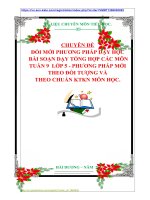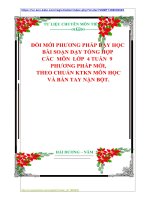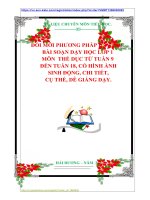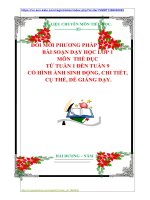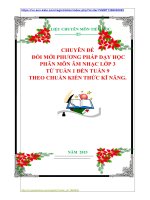Ta8 tuan 9 p25,26,27
Bạn đang xem bản rút gọn của tài liệu. Xem và tải ngay bản đầy đủ của tài liệu tại đây (161.02 KB, 13 trang )
<span class="text_page_counter">Trang 1</span><div class="page_container" data-page="1">
<b>Week 9- Period 26</b>
<i>Date of planning: 30/10/2022</i>
<b>UNIT 4: OUR CUSTOMS AND TRADITIONSLesson 1: Getting started</b>
<b>A. Objectives </b>
By the end of the lesson, ss will be able to: - Understand the text; do the reading tasks well.
<i>- Express obligation and necessity using the correct form of have to, then practice using the</i>
lexical items related to the topic above.
<b>1. Knowledge: </b>
- Vocabulary: lexical items related to customs and traditions. - Grammar: Present simple tense; should, shouldn’t, have to.
<b>2. Competence: Group work, individual work, pair work, linguistic competence,</b>
cooperative learning and communicative competence.
<b>3. Behavior: Be aware of protecting “custom and traditions”.B</b>
<b> . Teaching aids:</b>
<b>1. Teacher: Textbooks, teaching plan, teacher’s book…2. Students: Textbooks, notebooks…</b>
<i><b>a, Aims: To help Ss think about customs and traditions and to lead in the new lesson.b, Contents: Ss work individually to answer the questions.</b></i>
<i><b>c, Outcome: Ss can know about the topic they are going to study.d, Organization:</b></i>
- T asks some questions:
- Ss answer the questions. - T introduces the new lesson.
- How many ethnic minorities are there in Viet Nam?
- What do you know about Tay?
- Can you show their ethnic fashion and their customs?
- How do you understand about customs
</div><span class="text_page_counter">Trang 2</span><div class="page_container" data-page="2">and traditions?
<i><b>2. Presentation (12’) </b></i>
<i><b>a, Aim: To help Ss to know more items related to the topic “customs and traditions” and</b></i>
introduce the topic of the whole unit.
<i><b>b, Contents: </b></i>
+ Ss work individually to study new words.
+ Ss work individually to listen the dialogue, then work in pairs to read the dialogue.
<i><b>c, Outcome: Ss can know some lexical items related to the topic and know the topic of the</b></i>
whole unit.
<i><b>d, Organization:</b></i>
- T uses different techniques to teach vocabulary.
- Ss listen carefully the T’s modeling twice. Repeat in chorus and individually, then copy all the words.
<b>=> Checking: Matching</b>
<b>- T asks Ss to open their books and look at thepicture and the title under GETTINGSTARTED. </b>
- T asks them some questions:
<i>+ Who can you see in the picture?</i>
<i>+ What do you think the people in the pictureare talking about?</i>
<i> + What do you think the people in the pictureare talking about?</i>
- Ss answer. Then T collects ss' ideas
- T asks ss listen, read and check their prediction. Ss do it.
- T plays the recording twice. Ss listen.
- T checks the prediction. Then T asks ss to practice the conversation in pairs. Ss work in <i><b>+ compliment (n):lời khen ngợi</b></i>
<i>+ You’re kidding! (idiom):bạn nói đùa thếthơi</i>
<b>1. Listen and read</b>
<b> 3. Practice (20’)</b>
</div><span class="text_page_counter">Trang 3</span><div class="page_container" data-page="3"><i><b>a, Aim: To help Ss understand the conversation and know more about customs and</b></i>
<i><b>b, Contents: </b></i>
+ Ss work individually to find a words/ phrase that means. + Ss work individually to tick True (T) or False (F).
+ Ss work in pairs to answer the questions.
+ Ss work individually to find these sentences in the conversation and fill in the missing words.
+ Ss work individually to match the pictures with the costumes and traditions in the box. + Ss work individually to write C or T under each picture.
<i><b>c, Outcome: Ss can know some lexical items related to the topic and know the topic of the</b></i>
<i><b>- T has Ss look at the Watch out! Box and</b></i>
quickly read the information. Ss do it.
- T asks if Ss know any expressions with the
<i>same meaning as ‘You’re kidding’. </i>
<i>+ Some other expressions are: You must bekidding!/ You’re joking!/You must be joking!</i>
- T asks the Ss to do part b. Ss work individually.
- T asks them to compare their answers. - T corrects and remarks.
- T asks the Ss to do part c.
- Ss work in pairs to answer the questions. - T asks some pairs to read the answers. Some
<b>1a. Find a words/ phrase that means.</b>
<i>1. accepted 2. generations3. spot on 4. sharp</i>
<i>5. social 6. table manners</i>
<b>1b. Tick true or false.</b>
<i>1. T 2. F (There are also social ones.)3. T 4. F (There are a lot of customs fortable manners in the UK.)</i>
<b>1c. Answer the following questions</b>
<i>1. It’s eating dinner at 7 p.m. sharp.2. He’s surprised.</i>
<i>3. They both refer to doing somethingthat develops over time.</i>
<i>4. A custom is something accepted. Atradition is something special and ispassed down through the generations.5. They should find information about acustom or tradition.</i>
<b>1d. Find these sentences in the</b>
</div><span class="text_page_counter">Trang 4</span><div class="page_container" data-page="4">Ss read.
- T corrects and remarks
- T asks the Ss to do part 1d. Ss work
<b>- T has Ss look at the pictures and asks them</b>
what they see in each of them. Ss answer.
- Now T tells Ss that in the box are some
<i>customs and traditions of Vietnamese people. T</i>
explains the new words so that Ss understand the customs and traditions.
- T asks Ss to work individually to do task 2a. Ss do it.
- T calls some Ss to give their answers and write them on the board. Ss do it.
- T confirms the correct answers.
- T asks ss to work individually to decide if the pictures show customs or traditions and compare their answers in pairs. Ss do it.
- T has some Ss give the answers to the class and explain their choice.
<b>conversation and fill in the missingwords</b>
1. have to 2. should
<b>2a. Match the pictures with thecostumes and traditions in the box</b>
<i><b>a, Aim: To help Ss know more about their local customs and traditions.b, Contents: Ss work in groups to play the game.</b></i>
<i><b>c, Outcome: Ss can know more about their local customs and traditions.d, Organization:</b></i>
- T asks ss to work in groups of five or six. - T asks Ss to write down as many local customs and traditions as possible. The group
<b>3. Game: Customs and traditions experts</b>
</div><span class="text_page_counter">Trang 5</span><div class="page_container" data-page="5">with the most customs and traditions is the winner. The winning group presents their customs and traditions. Other groups add more if they can.
-T sets a time limit of five minutes. - Ss work in groups to play the game.
<b>3. Consolidation and guides for homework (2’)* Consolidation:</b>
- Asks ss to recall the main contents of the lesson - Consolidates ss more for ss to remember
<b>* Homework: Asks Ss to:</b>
- Complete the exercises in their notebooks and learn the new words
<i><b>- Prepare A closer look 1.</b></i>
<b>P. Hiệu trưởng</b>
<b>Nguyễn Thị Ngọc</b>
<b>Week 9 - Period 27</b>
<i>Date of planning: 30/11/2022</i>
<b>UNIT 4: OUR CUSTOMS AND TRADITIONSLesson 2: A closer look 1</b>
<b>A. Objectives </b>
By the end of the lesson, ss will be able to:
<i><b>- Practice more with vocabularies related to the topic “Customs and traditions”</b></i>
</div><span class="text_page_counter">Trang 6</span><div class="page_container" data-page="6">- Pronounce words containing the clusters /spr/ and /str/ correctly in isolation and in context.
<b>1. Knowledge: </b>
- Vocabulary: relating to customs and traditions.
- Grammar: Present simple tense; should, shouldn’t, have to.
<b>2. Competence: Group work, individual work, pair work, linguistic competence,</b>
cooperative learning and communicative competence.
<b>3. Behavior: Be aware of protecting “custom and traditions”.B</b>
<b> . Teaching aids:</b>
<b>1. Teacher: Textbooks, teaching plan, teacher’s book…2. Students: Textbooks, notebooks…</b>
<i><b>a, Aim: To help Ss think about customs and traditions.</b></i>
<i><b>b, Contents: Ss work individually to talk about customs and traditions.c, Outcome: Ss can talk about customs and traditions well.</b></i>
- Wearing ao dai on special occasions - Giving children lucky money at Tet …
<b>2. Presentation (6’)</b>
<i><b>a, Aim: To help Ss to know more the words related to the topic “customs and</b></i>
<i><b>b, Contents: Ss work individually study vocabulary.</b></i>
<i><b>c, Outcome: Ss can know more vocabulary related to the topic well.d, Organization:</b></i>
- T uses different techniques to teach
<i>vocabulary, follows the seven steps of</i>
</div><span class="text_page_counter">Trang 7</span><div class="page_container" data-page="7">- Ss Listen carefully the T’s modeling twice, repeat in chorus and individually and copy all the words.
<i><b>- Draws Ss’ attention to the Watch out!</b></i>
<i><b>Box. </b></i>
<i>- Explains to them the words ‘custom’ and‘tradition’ can be countable or uncountable.</i>
<i><b>a, Aim: To help Ss know the use of vocabulary and know how to pronounce words</b></i>
containing the clusters /spr/ and /str/ correctly in isolation.
<i><b>b, Contents: </b></i>
+ Ss work individually to match the column A with the column B. + Ss work individually to complete the expressions.
+ Ss work in groups to make sentences.
<b>+ Ss work individually to complete the sentences with their own ideas.</b>
+ Ss work individually to complete the words under the pictures with spr and str. Then listen and repeat.
<i><b>c, Outcome: Ss can know more vocabulary related to the topic and know how to</b></i>
pronounce words containing the clusters /spr/ and /str/ correctly in isolation well.
<i><b>d, Organization:</b></i>
<b>- T has Ss look at the table in the book and</b>
makes sure that they understand what to do. - T asks Ss to complete the exercise individually and then compare their answers with a partner. Ss work individually to do the task.
- T calls some Ss to give the answers. Ss give the answers.
- T confirms the correct answers.
- T has Ss read the sentences again to see if
<i>the word ‘custom’ or ‘tradition’ in each</i>
<b>1. Match the column A with the column</b>
<i>1. custom 2. tradition 3. according4. tradition 5. with 6. of 7. doing</i>
<b>3. Make sentences.</b>
Eg:
</div><span class="text_page_counter">Trang 8</span><div class="page_container" data-page="8">sentence is countable (C) or uncountable (U). - T has Ss read the sentences in 1 again and complete the expressions.
- Ss work individually to do the task. Then Ss compare their answers with a partner.
- T calls one or two Ss to write the complete expressions on the board.
- T checks and corrects the answers. - T asks Ss to run through the sentences - T asks Ss to work in groups to do this activity. Ss work in groups to make sentences.
- T prepares some pieces of big-size paper for the groups to write their answers on. When they finish, Ss stick their paper on the board.
- T asks ss to work individually to complete the sentences with their own ideas, then share their sentences with a partner. Ss work individually to do it.
- T lets some ss write the sentences on the board. Other ss give their comments.
-T confirms the correct answers.
- If time does not allow, T may assign this exercise as homework.
- T asks for Ss’ answers and write them on the board. Don’t say if they are right or wrong. Ss work individually.
- T plays the recording for them to check the answer and repeat the words.
- T plays the recording as many times as necessary.
<i>- According to tradition, we have fireworks on New Year’s Eve.</i>
<i>- My area broke with tradition by not having firecrackers on New Year’s Eve.- There’s a tradition in our province of having fireworks on New Year’s Eve.</i>
<b>4. Complete the sentences with your ownideas.</b>
<i>1. It’s the custom in my country that…. 2. We broke with tradition by ……</i>
<i>3. There’s a tradition in my family that……. 4. We have the custom of……….</i>
<i>5. According to tradition, ………..</i>
<i><b>II. Pronunciation /spr / and / str/</b></i>
<b>5. Complete the words under the pictureswith spr and str. Then listen and repeat</b>
<i><b>Key: 1.str 2.str 3.spr 4.spr</b></i>
<i> 5.str 6.str 7.spr 8.spr</i>
</div><span class="text_page_counter">Trang 9</span><div class="page_container" data-page="9"><b>3. Pronunciation (5’)</b>
<i><b>a, Aim: To help Ss know how to pronounce words containing the clusters /spr/ and /str/</b></i>
correctly in context.
<i><b>b, Contents: Ss work individually to listen and circle the words with /spr/ and /str/</b></i>
<i><b>c, Outcome: Ss can know how to pronounce words containing the clusters /spr/ and /str/</b></i>
correctly in context well.
<i><b>d, Organization:</b></i>
- T asks Ss to work individually to do the exercises. Ss do it.
- T plays the recording for ss to do this exercise, then asks for ss’ answers
- T plays the recording again for ss to repeat the sentences. Ss listen and repeat.
- T asks some ss to read out the sentences
<b>6. Listen and circle the words with /spr/and /str/.</b>
<b>* Keys</b>
<i>1. strictly 2. strangers/ spread</i>
<i>3. district, streets 4. filmstrip 5. offspring </i>
<b>3. Consolidation and guides for homework (2’)* Consolidation:</b>
- Asks ss to recall the main contents of the lesson. - Consolidates ss more for ss to remember.
<b>* Homework: Asks Ss to:</b>
- Learn by heart all the new words.
- Guides ss how to do Ex part A (workbook)
<b>- Prepare: A closer look 2</b>
<b>Week 10 - Period 28UNIT 4: OUR CUSTOMS AND TRADITIONS</b>
</div><span class="text_page_counter">Trang 10</span><div class="page_container" data-page="10"><i>Date of planning: 30/11/2022</i> <b>Lesson 3: A closer look 2A. Objectives </b>
By the end of the lesson, ss will be able to:
<i>- Use should and shouldn’t correctly and appropriately to give advice.- Express obligation and necessity using the correct form of have to.</i>
<b>1. Knowledge: </b>
- Vocabulary: lexical items related to customs and traditions. - Grammar:
<i>+ Should and shouldn't to express advice.+ Have to to express obligation or necessity.</i>
<b>2. Competence: Group work, individual work, pair work, linguistic competence,</b>
cooperative learning and communicative competence.
<b>3. Behavior: Be aware of protecting “custom and traditions”.B</b>
<b> . Teaching aids:</b>
<b>1. Teacher: Textbooks, teaching plan, teacher’s book…2. Students: Textbooks, notebooks…</b>
<i><b>a, Aim: To help Ss to use should/ shouldn’t to express advice.</b></i>
<i><b>b, Contents: Ss work individually to complete the sentences with should/ shouldn’t.c, Outcome: Ss can revise should/ shouldn’t to express advice well.</b></i>
<i><b>d, Organization:</b></i>
- T has ss complete the sentences and then compare the answers with a friend. Elicits students' answers.
- Ss work individually to do the task. - T confirms the correct ones.
<b>1. Complete the sentences with shouldn't</b>
</div><span class="text_page_counter">Trang 11</span><div class="page_container" data-page="11">+ To help Ss use “have to” to express obligation and necessity.
<i><b>b, Contents: </b></i>
+ Ss work individually to match the situation in A with the advice in B. + Ss work individually to study the remember box.
<i><b>c, Outcome: Ss can revise should/ shouldn’t, know how to use “have to” to express</b></i>
obligation and necessity and do related exercises well.
<i><b>d, Organization:</b></i>
<i>- T gives a situation: Your brother is goingout with a friend. The weather forecast saysit’s a hot sunny day. Give him some advice.</i>
- Ss share their ideas.
- T encourages Ss to express their advice freely.
<i>-> In this lesson we are going to review“should/shouldn’t” to express advice aboutcustoms and traditions. </i>
- T asks the Ss to work individually to do
- T checks and corrects.
<i>- T gives a situation: when we go to a place,it is obligatory that they follow its customsand traditions.</i>
-T asks Ss to read the information about how
<b>to use have to. Ss do it.</b>
<i><b>- T may want to add that must is also used to</b></i>
express obligation.
<i>- T asks Ss to answer the question: ? What arethe differences between have to and must? </i>
<i><b>Should and shouldn't to express advice</b></i>
<i><b>“Have to” to express obligation or necessity</b></i>
<i>+ “have to” is used to express obligation or</i>
It shows external obligation, i.e., someone else
<i><b>makes a decision about what you must do.</b></i>
<b> (+) have to / has to + infinitive</b>
<i>Example: We have to clean the house carefully</i>
before Tet.
<b> (-) don’t / doesn’t have to + infinitive</b>
<i>=> using when it is not necessary to do smtExample: She doesn’t have to wear a company</i>
<b>(?) Do / Does + subject + have to + infinitive</b>
<i>Example: Do we have to follow the tradition of</i>
cleaning the house before Tet?
<i>+ If you want to tell somebody not to dosomething as an obligation, use “must not/</i>
<i><b>mustn’t” instead. it is not necessary to do</b></i>
</div><span class="text_page_counter">Trang 12</span><div class="page_container" data-page="12"><i><b>- T asks SS to read the Remember! box. Ss do</b></i>
<b>3. Practice (20’)</b>
<i><b>a, Aim: To help Ss apply the grammar point “have to” to do related exercise well.b, Contents: </b></i>
<b>+ Ss work individually to complete the correct form of have to.</b>
+ Ss work individually to choose A or B to convey the meaning of the first sentences. + Ss work individually to find the mistakes and correct them.
<i><b>c, Outcome: Ss can revise should/ shouldn’t, know how to use “have to” to express</b></i>
obligation and necessity and do related exercises correctly.
- T checks and corrects.
- T asks the Ss to do task 4 individually. Ss
- T checks and corrects.
- T asks Ss to quickly read the e-mail and do this exercise individually, then compare the answers with a classmate. Ss work individually to do the task.
<b>3. Complete the correct form of have to.</b>
<i>1. have to 2. have to 3. has to4. had to/ don’t have to </i>
<i>5. does…have to 6. didn’t have to</i>
<b>4. Choose A or B to convey the meaningof the first sentences.</b>
<i>1. B 2. A 3. A 4. B</i>
<b>5. There are six mistakes find andcorrect.</b>
<i><b> (1) Shouldn’t give should give (reason:</b></i>
There are lots of confusing customs and traditions in Japan, so Eri thinks she should give Mi advance)
<i><b>(2) Has to have to (reason: the pronoun</b></i>
<i>‘you’ goes with ‘have to’)</i>
<i><b>(3) Shouldn’t wear should wear (reason:</b></i>
Eri says that Mi should take off her shoes when going inside, which means she should wear slippers)
<i><b>(4) Didn’t have to don’t have to (reason:</b></i>
this sentence is in the present time)
</div>